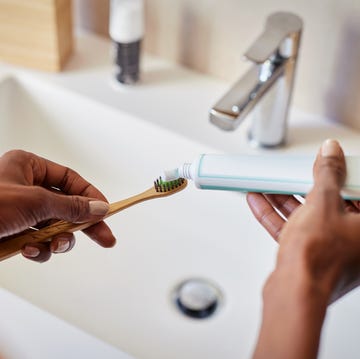Lately, there's been a lot of discussion about fluoride in tap water: Why is it there? Is it good or bad for our teeth and overall health? What will happen if it's removed? And why is this issue suddenly controversial?
According to a wide variety of experts, studies and major health organizations, cavities would become more common if fluoride was removed from tap water. “There certainly will be additional people that will develop decay that otherwise would not have, and those who are already at risk for tooth decay probably will see more of it,” says Scott L. Tomar, D.M.D., Dr.P.H., professor and associate dean for Prevention and Public Health Sciences at the University of Illinois Chicago College of Dentistry.
In addition, the American Dental Association, American Academy of Pediatrics and the U.S. Centers for Disease Control and Prevention continue to endorse community water fluoridation at optimal levels to help prevent tooth decay.
“Studies show that community water fluoridation prevents at least 25% of tooth decay in children and adults throughout their life span," said Linda J. Edgar, D.D.S., president of the American Dental Association, in a recent ADA press release. "The scientific weight of sound evidence around the benefit of community water fluoridation is clear and compelling.”
Why is fluoride added to tap water?
In the early 20th century, scientists in the U.S. and U.K. noticed that people whose communities had naturally fluoride-rich water had very few cavities — although they also had stains on their teeth. Further research determined that at low levels — 1 milligram per liter (mg/L) or less — fluoride strengthened teeth without discoloring them.
Based on this research, a number of pilot programs were put into effect to determine if adding fluoride to water would have the same affect as naturally fluoridated water on teeth health. The first was in 1945, when Grand Rapids, Michigan, became the first city to add fluoride to its water. More cities around the country followed, and by 2020, about 63% of Americans received fluoridated water, according to CDC data published May 15, 2024. In studies of new fluoridation programs, “we've seen a lower rate at which people develop decay, usually in the range of a 25% to 30% reduction in the severity of tooth decay,” says Dr. Tomar.
According to a 2015 report, U.S. Public Health Service recommends a fluoride concentration of 0.7 mg/L in drinking water.
How does fluoride help your teeth?
Fluoride fortifies your tooth enamel, the hard outer layer protecting the soft pulp and sensitive nerves inside. “It helps make the teeth stronger and more resistant to breakdown, and it helps remineralize or re-harden teeth that have begun to soften,” says Erica Caffrey, D.D.S., a clinical assistant professor of pediatric dentistry at the University of Maryland School of Dentistry and a consultant for the American Academy of Pediatric Dentistry’s Council for Clinical Affairs.
Enamel is mostly made of calcium and phosphorus, and acids from food or bacteria can wear these minerals away. “Fluoride works by helping to bring those calcium and phosphate ions back into the enamel structure,” says Dr. Tomar. “Then, when the fluoride gets incorporated into that mineralized structure, it actually becomes more resistant to future mineral loss when exposed to acids.”
Discussions about fluoride often center on children, since fluoride can strengthen kid’s teeth as they develop. However, fluoride can affect adult teeth, too. “People often forget that adults are still susceptible to decay, and the best available evidence suggests that community water fluoridation is effective at preventing tooth decay for adults, even for older adults,” Dr. Tomar says.
Why is there a debate about fluoride in tap water?
Robert F. Kennedy, Jr., the U.S. Secretary of Health and Human Services, shared a social media post on November 2, 2024, linking fluoride in water to various health problems. On January 6, 2025, a study review in the journal JAMA Pediatrics sparked discussion when it suggested a link between high fluoride levels in water and lower IQ scores in kids. “A number of reports have come out about fluoride exposure and children's IQ, and I'd say that that's probably what's driving a lot of the conversation in the public and in city council meetings and other places that are discussing fluoridation,” says Dr. Tomar.
However, this research doesn’t reflect fluoridated water in the United States, says Tomar. Many of the water samples studied came from countries with highly polluted water and fluoride levels far exceeding the 0.7 mg/L recommended by the U.S. Public Health Service. “All those accusations about impact on IQ and neural development — a critical reading of the literature just doesn't support it, at least at the levels that we have in this country,” Dr. Tomar says.
As with anything, there are risks and benefits to weigh, says Dr. Caffrey. “I would argue that the risks of dental decay are very serious and can lead to, at times, life-threatening consequences, particularly for children, but also for adults,” she says. From infections that travel elsewhere in the body to malnourishment when eating is painful, tooth problems can affect your whole body. “Oral health is really important for a child and an adult's ability to function and eat and sleep and smile and feel good about themselves,” she says.
What happens when communities stop fluoridating?
Tooth decay increases when fluoride goes away, research suggests. A study in Juneau, Alaska, showed an increase in kids with cavities after the city halted water fluoridation in 2007. When Calgary, Canada, stopped water fluoridation in 2011, kids got more cavities than children in nearby Edmonton, where water is still fluoridated, another study found. Young adults in Israel who were exposed to fluoridated water as kids — before the country stopped fluoridating water in 2014 — needed less dental treatment than those who weren’t, according to research on the country.
Despite the positive correlation between fluoridated water and fewer cavities, several towns around the country, including have stopped adding it.
What’s interesting is not everyone gets cavities when fluoride disappears from tap water. “The pattern that we see is that people that already have some risk for decay may wind up with more teeth that are affected or more parts of a tooth that are affected,” says Dr. Tomar.
Over time, eating lots of refined carbs or falling behind on your dental hygiene could add up. “Dental decay is a chronic disease process, so it's not like you eat one candy bar and wake up with a cavity the next morning,” says Dr. Caffrey. “There are multiple risk factors that can lead to that cavity or dental decay.”
How do I prevent tooth decay?
“Fluoride is one of the most essential tools for prevention of dental decay,” says Dr. Caffrey. Water is just one source. No matter what’s in your water, twice-daily teeth brushing and daily flossing are still the gold standard. Both Dr. Tomar and Dr. Caffrey recommend using fluoride toothpaste.
Nearly 100 toothpaste studies back up the claim that children, teens, and adults who regularly brush with fluoridated toothpaste have much less decay, researchers with the highly regarded Cochrane Library have determined.
If you don’t have fluoridated water, ask your dentist about supplementary fluoride sources like in-office fluoride treatments, fluoride mouthwash or daily fluoride drops or tablets for kids. Your dentist will consider your (or your child’s) risk factors to determine whether you could benefit from more fluoride, says Dr. Caffrey. For example, they might recommend it if you (or your child) have a family history of dental decay, use orthodontic appliances, have special dietary needs, take sweetened medications, breathe through your mouth at night or have fallen behind on dental visits. “At that point, we want all hands on deck, so if you don't have fluoride in water, it's like you've lost a tool for prevention — one more thing that could be helpful,” says Dr. Caffrey.
Unfortunately, adding a new fluoride source is not as easy (or cheap) as drinking from the tap. “It’s not really a great substitution for community water fluoridation because it's going to be far more expensive, far more dependent on having to go out and buy these things and remember to use it every day,” says Dr. Tomar.














